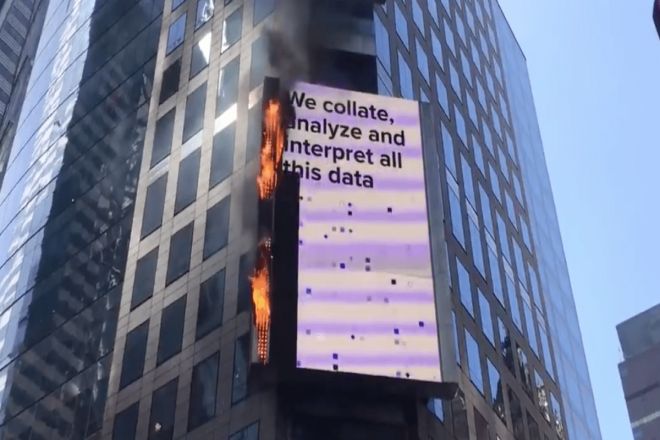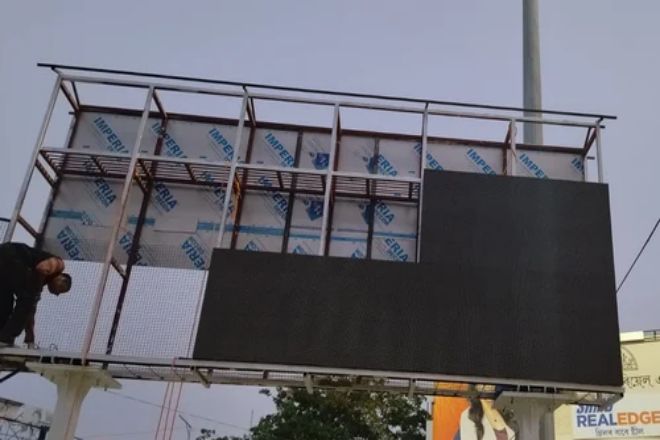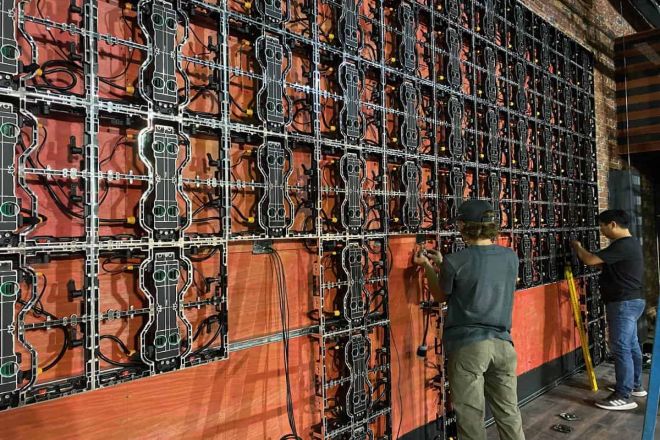Introduction

Against the background of the increasing trend of global warming, hot weather in summer has become more frequent and intense, with summer temperatures in many countries exceeding the 40-degree mark. In such a high-temperature environment, as a large electronic device that runs for a long time, the fire risk faced by the LED display cannot be ignored.
As an important part of modern cities, LED display screens are widely used in many fields, such as business, sports, culture, etc., adding rich colors to urban life. However, high temperatures will not only affect the normal operation of LED displays but may also cause fire accidents, posing serious threats to people’s lives and property safety.
Therefore, preventing LED display fires has become an urgent and important task. We must deeply analyze the root causes of fires and take effective measures to prevent them from the source.
1. The impact of fire on LED displays
The impact of fire on LED display screens is extremely serious, which is reflected in the following aspects:
First of all, fire will directly cause physical damage to the LED display. The high temperature of the fire will burn the circuit board and electronic components of the display, making the display unable to work properly. In addition, a fire may cause the display case to deform, melt, or even be completely destroyed, making the display completely lose its use value.
Secondly, fire will cause serious damage to the place where the LED display is located. If the display screen is installed in public places such as shopping malls and stadiums, fires will not only affect the normal operations of these places but may also pose a threat to people’s lives and property safety. The smoke and toxic gases brought by fires may also cause harm to people’s health.
In addition, fires will also have a negative impact on the brand image and reputation of LED displays. If the fire is caused by quality problems or improper installation of the display itself, the manufacturer and installation company may face legal liability and condemnation from public opinion. Not only does this affect their business interests, but it may also damage their image and reputation.
Therefore, in order to avoid the impact of fire on LED displays, we should start with prevention and take effective measures to reduce fire risks. This includes selecting qualified LED display products, reasonably planning the placement, regularly inspecting and maintaining electrical equipment, and strictly controlling the current used.
At the same time, we should also strengthen the construction of fire emergency response capabilities, formulate emergency plans, and configure fire extinguishing equipment to ensure that fires can be handled quickly and effectively when a fire occurs.
2. Analysis of the causes of LED display fires

Unreasonable circuit design and overload operation lead to heating: If the circuit design of the LED display fails to fully consider the current and voltage carrying capacity or exceeds the designed load range in actual use, it may cause electrical problems inside the display. The components are overloaded and generate a lot of heat. Long-term high-temperature conditions will accelerate the aging of electrical components and may even cause fires.
- Poor heat dissipation system cannot effectively dissipate heat:
The LED display will generate a certain amount of heat during operation. If the heat dissipation system is improperly designed or the heat dissipation effect is poor, the heat cannot be dissipated in time, causing the internal temperature of the display to continue to rise. This high-temperature environment not only affects the normal operation of the display screen but may also cause a fire.
- Improper material selection and flammable materials increase fire risks:
The production process of LED displays involves a variety of materials. If flammable or fusible materials are used, they may burn quickly and spread once they encounter high temperatures or fire sources. Leading to fire.
- Poor installation environment, such as poor ventilation, dust accumulation, etc.:
The installation environment of the LED display is crucial to its safe operation. If the installation environment is poorly ventilated, the heat generated by the display cannot be dissipated in time, or dust accumulation in the environment affects the heat dissipation effect, which may increase the risk of fire.
- Human operating errors, such as illegal use, improper maintenance, etc.:
Human factors are also one of the important causes of LED display fires. If the operator uses the display screen illegally, such as overloading it for a long time, using an improper power supply, etc., it may cause a fire. In addition, if the display screen is not properly maintained, such as not cleaning dust in time, replacing aging electrical components, etc., it may also lead to fires.
Therefore, in order to prevent LED display fires, it is necessary to comprehensively consider the above factors and take effective measures to prevent them from aspects such as circuit design, heat dissipation system, material selection, installation environment, and human operation.
At the same time, regular inspection and maintenance are also essential to ensure the safe and stable operation of the display.
3. Measures to prevent LED display fires
- Choose qualified LED display products to ensure they meet safety standards:
When purchasing LED displays, you should choose products that are certified and of reliable quality. Ensure that products comply with national and industry safety standards and reduce fire risks from the source. At the same time, pay attention to the production date, shelf life, and other information about the product, and avoid using old or obsolete products.
- Reasonably design the circuit to avoid overload operation and regularly check line safety:
During the design and installation process of LED display screens, the carrying capacity and safety of the circuit should be fully considered. Avoid overload operation and ensure that the current and voltage are within a reasonable range. In addition, the safety status of the lines should be checked regularly, and aging or damaged lines should be replaced in a timely manner to ensure the stable operation of the circuit system.
- Strengthen the construction of the cooling system to ensure effective heat dissipation of the display:
The heat dissipation system is the key to preventing LED display fires. The heat dissipation design should be optimized, and efficient heat dissipation materials and structures should be used to ensure that the display can effectively dissipate heat during operation. At the same time, the cooling holes, fans, and other components should be cleaned regularly to keep the cooling system unobstructed.
- Choose flame-retardant materials to reduce the risk of fire:
During the production and installation of LED displays, flame-retardant or flame-retardant materials should be used as much as possible. These materials are less likely to burn or burn more slowly when exposed to high temperatures or fire sources, helping to reduce the risk of fire. At the same time, effective fire prevention measures should be taken for combustible materials that must be used, such as applying fire retardant coatings.
- Improve the installation environment, maintain good ventilation, and clean dust regularly:
The installation environment of the LED display is crucial to its safe operation. Ensure that the installation site is well-ventilated to avoid heat accumulation inside the display. At the same time, dust on the surface and inside of the display must be regularly cleaned to maintain its cleanliness and heat dissipation effect. For displays installed outdoors or in harsh environments, protective measures should be added, such as installing sunshades, waterproof covers, etc.
- Strengthen personnel training, improve operation and maintenance levels, and prevent human errors:
Regular training should be conducted for operation and maintenance personnel to improve their professional skills and safety awareness. Ensure that they can operate and maintain LED displays correctly to avoid fire accidents caused by illegal operations or improper maintenance.
At the same time, strict operating procedures and maintenance systems should be established to regulate personnel behavior and reduce the risk of human errors.
4. Emergency treatment of LED display fire

- Develop a fire emergency plan and clarify emergency response procedures:
For the fire risk of LED display screens, detailed fire emergency plans must be formulated in advance. The plan should cover multiple aspects such as the initial detection of fire, alarm, evacuation, rescue, and follow-up treatment to ensure that emergency response can be carried out quickly and orderly when a fire occurs.
The plan should also clarify the responsibilities and division of labor of each department, as well as the command system for emergency response, to ensure the smooth flow of information and the effective allocation of resources.
- Equip fire extinguishing equipment to ensure that fires can be put out in time in the early stages:
A sufficient number of fire extinguishers and fire extinguishing equipment should be installed around the LED display. These equipment should be inspected and maintained regularly to ensure that they are in good working condition.
Once a fire breaks out, employees should be able to quickly use this equipment to carry out initial firefighting, control the spread of the fire, and gain valuable time for subsequent rescue work.
- Conduct regular fire emergency drills to improve employees’ emergency handling capabilities:
In order to familiarize employees with the contents of fire emergency plans and master emergency response skills and methods, fire emergency drills should be organized regularly. By simulating real fire scenarios, employees can learn and improve in practice to ensure that emergency response can be carried out quickly and accurately when a fire occurs.
After the drill, experiences, and lessons should be summed up in a timely manner, and the plan should be revised and improved.
In addition, in order to prevent the occurrence of LED display fires, management and monitoring need to be strengthened from the source. For example, strengthen daily inspection and maintenance of equipment to promptly discover and deal with potential safety hazards.
Strengthen fire safety training for employees to improve their fire safety awareness and self-prevention and self-rescue capabilities; and establish a complete fire safety management system to ensure that all Safety measures are effectively implemented.
Through this article’s analysis of the causes of LED display fires and discussion of preventive measures, we deeply understand the importance and urgency of preventing LED display fires. In the high-temperature environment caused by global warming, the fire risk of LED displays is more prominent and must attract our attention.
Conclusion
In order to ensure the safe operation of LED displays and protect people’s lives and property, we need to start from multiple aspects and take comprehensive measures for prevention. This includes strengthening product design, optimizing heat dissipation systems, selecting flame-retardant materials, improving the installation environment, and improving personnel operation and maintenance levels.
Finally, if you want to know more information about LED displays, please get in touch with us.
